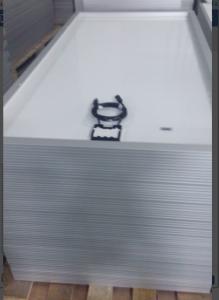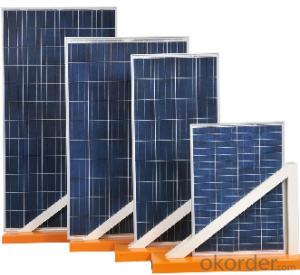Wind and Solar Panels - Monocrystalline Silicon Solar Modules 48cell-220w
- Loading Port:
- China Main Port
- Payment Terms:
- TT or LC
- Min Order Qty:
- 1000 watt
- Supply Capability:
- 10000000 watt/month
OKorder Service Pledge
OKorder Financial Service
You Might Also Like
1. Structure of Monocrystalline Silicon Solar Modules 48Cell-220W Description
Solar panel refers either to a photovoltaics (PV) module, a solar hot water panel, or to a set of solar photovoltaics modules electrically
connected and mounted on a supporting structure. A PV module is a packaged, connected assembly of solar cells. Solar panels can be
used as a component of a larger photovoltaic system to generate and supply electricity in commercial and residential applications. Each
module is rated by its DC output power under standard test conditions, and typically ranges from 100 to 320 watts.
2. Main Features of the Monocrystalline Silicon Solar Modules 48Cell-220W
• WARRANTIES
- 10-year limited product warranty1.
Tests by independent laboratories prove that modules:
- High effi ciency, multicrystalline silicon solar cells with high transmission and textured glass deliver a module effi ciency of up to 16.0%,
minimizing installation costs and maximizing the kWh output of your system per unit area.
- Tight positive power tolerance of 0W to +5W ensures you receive modules at or above nameplate power and contributes to minimizing
module mismatch losses leading to improved system yield.
.
.
3. Monocrystalline Silicon Solar Modules 48Cell-220W Images



4. Monocrystalline Silicon Solar Modules 48Cell-220W Specification
窗体顶端 Electrical parameters at Standard Test Conditions (STC)窗体底端 | |||
Power output | Pmax | W | 220 |
Power output tolerances | ΔPmax | W | 0 / + 5 |
Module efficiency | ηm | % | 16.7 |
Voltage at Pmax | Vmpp | V | 24.6 |
Current at Pmax | Impp | A | 8.94 |
Open-circuit voltage | Voc | V | 31.1 |
Short-circuit current | Isc | A | 9.48 窗体底端 |
5. FAQ of Monocrystalline Silicon Solar Modules 48Cell-220W
Q1:Can we visit your factory?
A1:Sure,welcome at any time,seeing is believing.
Q2:Which payment terms can you accept?
A2:T/T,L/C,Moneygram,Paypal are available for us.
Q3:How to guarantee the Quality of the products?
A3:We have established the international advanced Quality management system,every link from raw material to final product we have strict Quality test;We resolutely put an end to unQualified products flowing into the market. At the same time, we will provide necessary follow-up service assurance.
- Q: is this fact true? - its a limitation to solar panels during summer when it's in extremly hot countrie. I've heard it from my science teacher .. please give detail if you have any and any more benefits/limitations is welcomed .. Thank you :) !
- So what do higher temperatures do to solar photovoltaic panels? As temperatures rise, the efficiency of solar panels decreases. Heat causes electrical resistance to the flow of electrons. On days where the temperature is more than 75 degrees, the electrical resistance makes the voltage fall thereby producing less kilowatts per hour. Your roof is much hotter than temperatures on the ground. That’s why solar panels are not mounted flat to a roof. There’s usually a few inches of spaces between the panels and roof so air flow can easily pass through and cool the panels down. There are some photovoltaic panels that are designed specifically to operate in hotter temperatures. These panels have a higher temperature coefficient. This is especially important in high heat climates like Arizona or New Mexico, but probably wouldn’t make too much of a difference in New England (except maybe this year). If you do live in one of these areas, you should speak to your solar installer to make sure they are using they right equipment for your region. Please note: Solar thermal panels used to heat water can withstand high temperatures without any degradation. In fact, hotter temperatures would actually be better for these types of modules.
- Q: Can solar panels be used for powering electric lawnmowers or gardening tools?
- Yes, solar panels can be used to power electric lawnmowers or gardening tools. They can be connected to a battery system that stores the solar energy and then powers the electric equipment. This provides a sustainable and eco-friendly alternative to traditional power sources.
- Q: Can solar panels be used for air conditioning?
- Yes, solar panels can be used for air conditioning. Solar panels generate electricity from sunlight, which can be used to power air conditioning units. By using solar energy, homeowners and businesses can reduce their reliance on traditional electricity sources and decrease their carbon footprint. However, the efficiency and effectiveness of using solar panels for air conditioning may vary depending on factors such as the size of the solar system, location, and energy requirements of the air conditioning unit.
- Q: I've found something called maximum system voltage 000v on my 0 w panel nameplate. Its impossible for 0w to have 000v, right?
- Hi No i very much doubt it could produce that sort of voltage so get a voltmeter and check it. bright sunshine and dark.
- Q: We are thinking about useing solar panels for our house.Does anyone know about solar panels? If so could you please tell me some information on them,and the cost for a home,to install them.
- If solar power is not practical, why do four of my friends and I have it? Actually Don M is mostly right. The factors to consider when contemplating a solar installation are numerous. For example my system will not pay for itself in utility savings in my lifetime, but I plan to sell the house soon. What I am saving on electricity costs, and the increased amount I can ask a buyer, I will come out well ahead. Cruise the Internet and look in the green search box at the top of this page, for solar panels. As you learn more, you can come back with more questions.
- Q: So I want to power one of my car fans with some solar panels. I ordered quite a few and I want to power one of my fans under the hood. I've already disconnected the fan and pulled it out of the car to test it later.What all do I need besides the panels, fan, and wiring to make this work. This fan will not be tied to any other system. Currently, the fan is not operated by the car or any system of the car due to a modification made to the automobile allowing me to disconnect it from use months ago.Using the fan powered from the solar panels would help with the modification to increase air flow and speed into the area.Could someone please help me by telling me what else I need to make the fan operational from here?
- The solar panel doesn't output enough power to run the fan directly, your best bet would be to just hook the fan back up to the battery, and then rig the solar panels up to help charge the battery and remove some of the load from the alternator. If you're trying to reduce your emissions/increase fuel economy then you'd be better of setting up a switch to disconnect your alternator when its not necessary to have it on. The alternator runs off a belt from the engine which requires some of the power output from the engine. Having this connected all the time increases the amount of gas used (marginally) but you'd be saving more gas doing that and using the solar panels to keep the battery topped up.
- Q: Are there any fire hazards associated with solar panels?
- Yes, while solar panels themselves do not pose a significant fire hazard, there are some potential fire risks associated with their installation and operation. These risks primarily stem from electrical malfunctions, such as faulty wiring, improper installation, or damage to the electrical components. Additionally, in rare cases, solar panels can contribute to the spread of fire by acting as a source of fuel or by hindering firefighting efforts due to their presence on rooftops. However, with proper installation, regular maintenance, and adherence to safety guidelines, the fire hazards associated with solar panels can be minimized.
- Q: Can solar panels be used for powering security systems?
- Yes, solar panels can be used to power security systems. Solar panels convert sunlight into electricity, which can be used to power various devices, including security cameras, alarms, and sensors. This allows security systems to operate independently of the electrical grid, making them more reliable and cost-effective in remote locations or areas prone to power outages. Moreover, solar-powered security systems are also environmentally friendly, reducing reliance on fossil fuels and minimizing carbon emissions.
- Q: how the energy of load connected to solar PV measure.?Want too the basic idea about it.The role of current flowing thrugh the load?Can u explain with example..can explain simply?Im not an electrical student so explain very basics
- Most PV solar panels are labelled with their peak power output - this is the maximum power (measured in Watts) which that panel can generate in full sunlight. Remember these simple formula- V=IR and P=VI The current flowing through load keep the flow of electrons and thus energy is produced.
- Q: I need to know where I can buy the parts or find them as scrap to make my own solar panels. Is there a cheap way of buying the panels or can I make them myself.
- Build okorder /
Send your message to us
Wind and Solar Panels - Monocrystalline Silicon Solar Modules 48cell-220w
- Loading Port:
- China Main Port
- Payment Terms:
- TT or LC
- Min Order Qty:
- 1000 watt
- Supply Capability:
- 10000000 watt/month
OKorder Service Pledge
OKorder Financial Service
Similar products
Hot products
Hot Searches
Related keywords




























